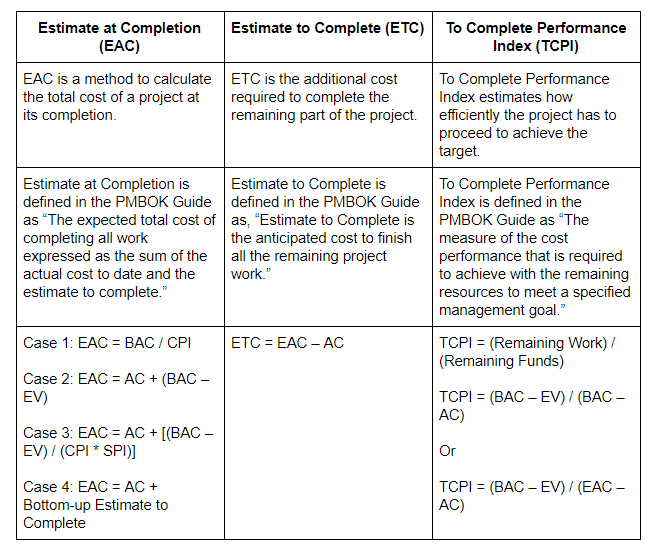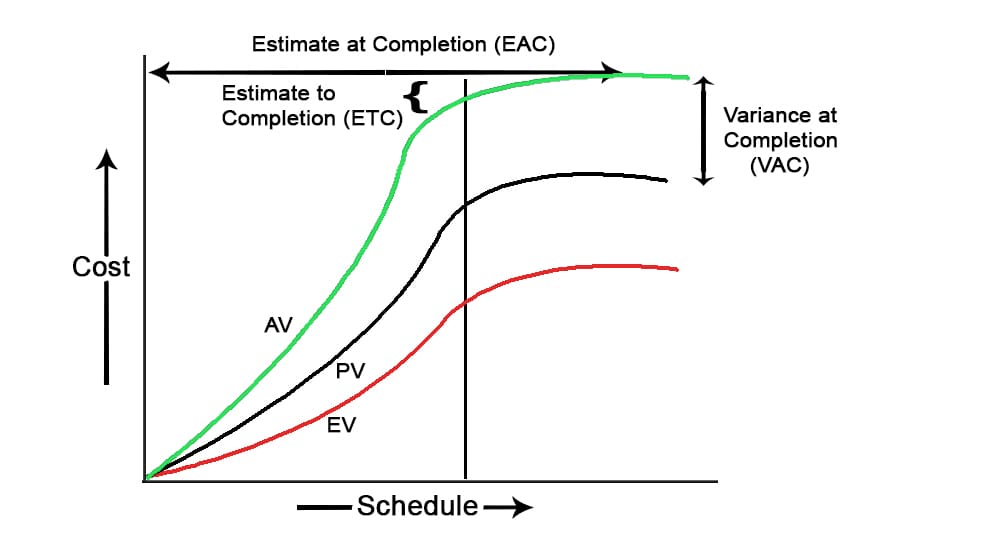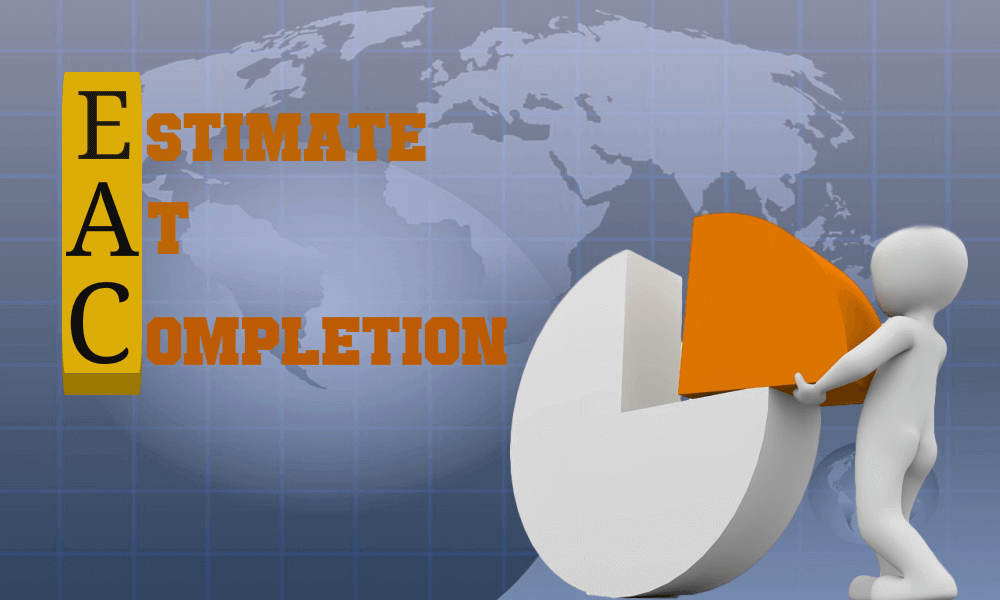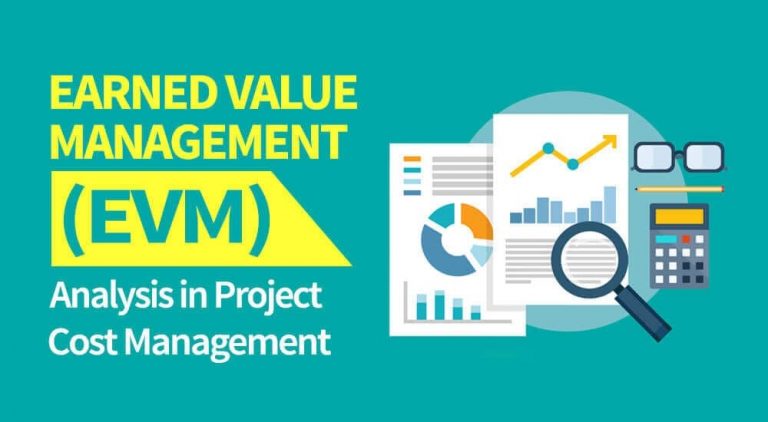Monitoring and controlling the budget is vital in project management, as stakeholders are concerned about cost overruns. Estimate at Completion (EAC) is a forecasting tool to help achieve this objective.
Today, we will discuss this forecasting tool in detail with its mathematical formula and examples of calculations.
Let us delve in.
What is the Estimate at Completion (EAC)?
According to the PMBOK Guide, estimate at completion (EAC) is “the expected total cost of completing all work expressed as the sum of the actual cost to date and the estimate to complete.”
Put simply, it predicts the total cost of a project once it’s finished. It considers the project’s current performance and adjusts the initial cost estimate based on actual performance. EAC helps project managers guess if they can complete the project within budget or if extra funding is required.
Mathematically, EAC is the spent cost plus the expected cost required to complete the remaining project work. This metric helps project sponsors or management adjust the budget on time to avoid delays and risks.
EAC helps stakeholders manage budgets efficiently according to current conditions. It is a projection of the total cost a project is expected to incur upon completion.
Apart from EAC, you have two more project forecasting techniques:
- Estimate to Complete (ETC)
- To Complete Performance Index (TCPI)
Importance of Estimate at Completion
Effective project management depends on accurate budget planning and expenditure, and EAC plays a key role in this endeavor. EAC allows project managers to allocate resources correctly and make informed decisions that align with budgetary expectations by providing a realistic projection of the total cost to complete a project.
According to a survey (PMI’s Pulse of the Profession 2022) conducted by the PMI, 71% of projects that exceeded their budget listed “inadequate cost estimation” as one of the leading causes. Using an estimate at completion helps mitigate such risks and ensures that the project stays within its limits.
Impact of Estimate at Completion on Projects
A study by the International Journal of Project Management found that organizations using EAC practices experienced a 20% reduction in cost overruns. This shows the tangible benefits of using EAC in project management and its correlation with cost control success.
Examples of EAC
You can calculate the estimate at completion using four different scenarios.
Case #1: EAC = BAC / CPI
You assume that the project will continue to perform, to the end, as it has been performing in this scenario.
In other words, your future performance will be the same as your past performance. Therefore, the CPI will remain unchanged until the project ends.
Formula for Estimate at Completion
You can calculate the estimate at completion by dividing the budget at completion (BAC) by the cost performance index (CPI).
Estimate at Completion = (Budget at Completion) / (Cost Performance Index)
Or,
EAC = BAC / CPI
- If the CPI = 1, then EAC = BAC. This means you can complete your project with your approved budget analysis.
- The estimate at completion will be equal to the budget at completion at the start of the project (i.e., EAC = BAC).
Example #1
You have a project to be completed in 12 months, and the cost is 100,000 USD. Six months have passed, and 60,000 USD has been spent, but upon closer review, you find that only 40% of the work has been completed.
Find the estimate at completion (EAC) for this project, given the question:
Budget at completion (BAC) = 100,000 USD
Actual Cost (AC) = 60,000 USD
Planned Value (PV) = 50% of 100,000
= 50,000 USD
The question did not say that the Planned Value was 50%. However, it says that the duration is 12 months, and 6 months have passed. In this case, you can safely assume that the PV was 50% unless it is given in the question.
Earned Value (EV) = 40% of 100,000
= 40,000 USD
First, you have to calculate the cost performance index to calculate the EAC:
Cost Performance Index (CPI) = EV / AC
= 40,000 / 60,000
= 0.67
=>Cost Performance Index (CPI) = 0.67
Now,
Estimate at Completion (EAC) = BAC / CPI
= 100,000 / 0.67
= 149,253.73
Hence, the estimate at completion (EAC) is 149,253.73 USD.
In other words, if the project continues with CPI = 0.67 until the end, then you must spend 149,253.73 USD to complete it.
The estimate at completion (EAC) provides the amount of money that the project will cost.
The estimate at completion can be determined by four methods, depending on how the project performs. However, from a PMP certification exam standpoint, the first method is the most important. There is a smaller chance that you will see questions based on the others.
Case #2: EAC = AC + (BAC – EV)
You have deviated from your budget estimate, but you can complete the remaining work as planned.
Unforeseen circumstances or one-time incidents can cause this and increase costs. However, it will not happen again, and you can complete the remaining work as planned.
In this formula, you add the money spent to date to the budgeted cost of the remaining work.
Formula for Estimate at Completion
The formula to calculate the estimate at completion in this case, is:
Estimate at Completion = Money Spent to Date + Budgeted Cost for the Remaining Work
EAC = AC + (BAC – EV)
Example #2
You have a project with a budget of 500,000 USD. An incident during the execution phase costs a lot of money. However, you are sure that this will not happen again, and you can continue with your calculated performance for the rest of the project.
To date, you have spent 200,000 USD, and the value of the completed work is 175,000 USD.
Calculate the estimate at completion (EAC).
You will use this formula because the cost increase is temporary, and you can complete the rest of the project as planned.
Estimate at Completion = Money Spent to Date + (Budgeted Cost for the Remaining Work – Earned Value)
EAC = AC + (BAC – EV)
Given the question:
Actual Cost (AC) = 200,000 USD
Budget at Completion (BAC) = 500,000
Earned Value (EV) = 175,000
Therefore:
EAC = 200,000 + (500,000 – 175,000)
= 200,000 + 325,000
= 525,000 USD
Therefore, the Estimate at Completion is 525,000 USD.
Case #3: EAC = AC + [(BAC – EV) / (CPI * SPI)]
You are over budget, behind schedule, and the client insists you complete the project on time. The cost and schedule performance must be taken into consideration.
Formula for Estimate at Completion
Estimate at Completion = Money Spent to Date + (Budgeted Cost for Remaining Work – Earned Value) / (Cost Performance Index * Schedule Performance Index)
EAC = AC + [(BAC – EV) / (CPI * SPI)]
Example #3
You have a fixed deadline for a project with a budgeted cost of #500,000 USD. To date, you have spent 200,000 USD, and the value of the completed work is 175,000 USD. However, according to the schedule, you should have earned 225,000 USD by now.
Calculate the estimate at completion (EAC), given the question:
Budget at Completion (BAC) = 500,000 USD
Actual Cost (AC) = 200,000 USD
Earned Value (EV) = 175,000 USD
Planned Value (PV) = 225,000 USD
To calculate the EAC, first, you have to calculate the CPI and SPI:
SPI = EV / PV
= 175,000 / 225,000
= 0.78
CPI = EV / AC
= 175,000 / 200,000
= 0.88
Now, you can use the formula:
EAC = AC + [(BAC – EV) / (CPI * SPI)]
= 200,000 + (500,000 –175,000) / (0.88 * 0.78)
= 200,000 + 325,000 / 0.69
= 200,000 + 471,000
= 671,000 USD
Hence, the estimate at completion is 671,000 USD.
Case #4: EAC = AC + Bottom-Up Estimate to Complete
In this situation, you find out that your cost estimate was flawed, and you must calculate the new cost estimate for the remaining project work.
Here, you will go to the activity level to find each cost, add them, and get the cost of the remaining work.
Example #4
You have a project to construct a government department building for 500,000 USD. To date, you have spent 200,000 USD, and the value of the completed work is 175,000 USD. However, you notice that your cost estimation was flawed. Therefore, you need to calculate your budget again for the remainder of the project.
You gather your team members and re-estimate the cost of the remaining work. Your new estimate shows that it will require 400,000 USD to complete the remainder of the project.
Calculate the estimate at completion (EAC) given the question:
Budget at Completion (BAC) = 500,000 USD
Actual Cost (AC) = 200,000 USD
Earned Value (EV) = 175,000 USD
Bottom-Up Estimate to Complete = 400,000 USD
Here, you will use the formula:
EAC = AC + Bottom-Up Estimate to Complete
= 200,000 + 400,000
= 600,000 USD
Therefore, the estimate at completion is 600,000 USD.
EAC Vs BAC
EAC and BAC are cost estimates. The BAC is determined initially, while the EAC is determined during the project and considers all risks and deviations from cost and schedule baselines.
EAC is a dynamic projection of the total cost that the project is expected to incur after completion. It considers actual costs incurred and the estimated costs to complete the remaining work. EAC provides a realistic estimate by considering the project’s current performance.
Budget at completion (BAC) is the original baseline budget established at the beginning of the project. It represents the total authorized budget for the entire project.
EAC provides the adjusted estimate based on the project’s actual performance and current conditions, while BAC represents the initial budget set at the project’s outset. EAC is dynamic and adaptable, while BAC is static data.
EAC Vs ETC
Estimate at completion (EAC) is a projection of the total cost a project will incur when it is completed. It considers the actual costs incurred and the estimated costs for completing the remaining work.
Estimate to Complete (ETC) is a forward-looking estimate of the cost required to complete the remaining project work in a project. It focuses solely on the expected costs for the work yet to be done without considering the actual costs incurred.
ETC is a targeted estimate for the remaining work without considering past performance. EAC gives a comprehensive view of the project’s overall cost status, whereas ETC provides a more focused estimate for future expenses.
Estimate at Completion (EAC) Table

Estimate at Completion (EAC) Graph

Frequently Asked Questions
Q: Why is EAC important for project managers?
EAC helps project managers make informed decisions, adjust resource allocation, and communicate realistic budget expectations to stakeholders.
Q: Can EAC be used for ongoing project monitoring?
EAC is a valuable tool for monitoring project cost performance throughout its lifecycle, allowing for timely adjustments and risk management.
Q: What role does EAC play in risk management?
EAC assists in identifying potential cost overruns or savings in the project, enabling project managers to address risks proactively.
Q: How does EAC contribute to accurate project forecasting?
EAC contributes to accurate forecasting by considering past project performance and estimated future costs, thus providing a realistic projection.
Q: Can EAC be adjusted during the project lifecycle?
EAC is designed to be a dynamic measure that can be adjusted as the project progresses, incorporating scope, schedule, and cost changes.
Q: How does EAC support effective cost control?
EAC helps identify variances between the original budget and the projected cost, facilitating effective cost-control measures to keep the project within budget constraints.
Summary
Estimate at completion is an excellent forecasting tool. It allows project managers to make realistic budget revisions. It gives you a mid-project estimation of the costs that your project may require to complete. Once this estimate is approved, this will be your new budget. The EAC is not fixed; it may change as the project progresses. The estimate at completion should be revised periodically or as defined in the project-management plan.
This topic is important from a PMP exam point of view.
This blog post is the fifth in eleven series on Earned Value Management and project forecasting. Please read through my previous posts before reading this post if you’re coming here from a search engine or a referral.
The following are the links for other blog posts:
- Earned Value Management
- Elements of Earned Value Management
- Budget at Completion in Project Management
- Cost Variance in Project Management
- Schedule Variance in Project Management
- Cost Performance Index in Project Management
- Schedule Performance Index in Project Management
- Schedule Variance and Cost Variance
- Schedule Performance Index and Cost Performance Index
- Estimate at Completion (You are here)
- Estimate to Complete
- To Complete Performance Index

I am Mohammad Fahad Usmani, B.E. PMP, PMI-RMP. I have been blogging on project management topics since 2011. To date, thousands of professionals have passed the PMP exam using my resources.








First of all…very helpful so thanks. I believe i see an error where “Budgeted cost for the remaining work” already includes the subtraction of the earned value in Case 3.
Estimate at Completion = Money spent to date + (Budgeted cost for the remaining work – Earned Value) / (Cost Performance Index * Schedule Performance Index)
EAC = AC + (BAC – EV) / (CPI * SPI)
Please refer to the PMBOK Guide 6th edition page: 265.
The formula is right, but in the explanation it is saying budgeted cost of work remaining is equal to BAC – EV
It should either say Budget at completion – Earned value (BAC – EV)
or just say Budgeted cost of Work remaining for (BAC – EV) because the fact is
BAC – EV is actually the Budgeted Cost of Work Remaining
What is “Earned value (BAC – EV)”
I’ve tried using all 4 formulas for EAC with same scenario (example below) and getting different values as results. Do this mean that we have to pick the right formula according to project situation or else we might get misleading information/interpretation?
Example:
BAC = 100,000
AC = 60,000
EV = 40,000
PV = 50,000
Every formula should be used for corresponding situation.
Fahad,
Many thanks for your explanations. I’m finding them very helpful. One question.
In Case 3, why wasn’t the calculation 200,000+325,000 = 525,000 then 525,000/.69 = $760,870
Please explain. Many thanks, Trudy
Hello Trudy, you have to input values in formulas as is. Derivation of this formula is beyond the scope of the PMP exam.
Hi Fahad,
I have a question about what you said about EAC especially with the statement of formula:
EAC = AC + (BAC – EV)
why are you say (Budgeted cost of the remaining work – Earned Value) … correct me if I’m wrong.
Regards
Abahussein
It is Budgeted Cost of the work – Earned Value.
Working as a Contractor with signed contract agreement, estimate can’t be altered. Please guide in this scenario.
If it is a fixed priced contract, the cost cannot be changed.
I have been teaching and accomplishing Earned Value Project Analysis for over 20 years and I do have some spreadsheets for the development of IEACs.
Your for the asking.
Thanks Roger for asking. You can send them at [email protected]
when you say a project is complete?
a) budget at completion is equal to earned value
b) Earned value is equal to Cost value
write the most authentic relationship
When the project is completed, earned value is equal to planned value.
When you revise the budget, your EAC will be your new BAC.
Hello Fahad
I could not pass my PMP in first attempt. I am studying again. The exam is changing after Jan 11th. What would be your suggestion about changes coming up. Should I try to give exam before or after. Kindly advise.Thank you
One month time is enough to prepare for the second attempt. You can try it before the exam changes.
Fahad,
When can we apply these formulas?
EAC= AC+(BAC-EV)/CPI*SPI
EAC=AC+(BAC-EV)/CPI
EAC=BAC/CPI
EAC=BAC/CPI*SPI
All three formula mentioned in the PMBOK Guide has already been explained in this blog post.
Dear Fahad,
Thanks for the detailed explanation.
I am confused with some calculation and need guidance.
In the 1st example(1st case) where EAC = BAC/CPI, BAC = 100000, EV = 40000 and AC = 60000. CPI = 0.67 thus EAC = 100000/0.67 = 149253.7
But if we calculate it in another way EAC = 100000/(40000/60000), as per cross calculation EAC = (100000 * 60000)/40000 = 150000.
We get accurate values for normal equations like 5/(2/10) which can be 5/0.2 still 25 and 5*10/2 still 25. Here i am unable to understand the reason for this difference.
Can you guide !!
Regards,
Reshma
I took the round figure in decimal for CPI, that is why you are seeing this difference.
See references Marked for review
61. You are performing earned value technique on your project.
After budget approval, an additional and unexpected cost item has been identified, which made the project more expensive some weeks ago. The item has meanwhile been paid by the project team, and it is expected that for the remaining duration of the project, costs will be as budgeted.
In this case, which is the best formula to calculate EaC (Estimate at Completion)?
1 EaC = BaC – CV
2 EaC = BaC / CPI
3 EaC = AC + BtC / CV
4 You can not compute the EaC.
Hi Fahad
Do we generally take the Commitments when we calculate the Actual Cost ?(to elaborate, Actual Cost todate + Commitments= Total Cost). To arrive at Estimate at Completion, is it fair to consider the Total cost rather tahn the Actual cost (as its already commited for the project) and estimate to complete should be remaining work to be done excluding the commitments.
Please throw some light on this
Thanks
Shri M
Whatever you have spend is Actual Cost.
For the other part, I did not understand you question clearly. Please explain it again if you can.
Hi Fahad,
Saw this pmstudy and it explains formula’s very well. I have a query regarding
Case-III: EAC = AC + (BAC – EV)/(CPI*SPI)
You are over budget, behind schedule, then you use (CPI * SPI) both
a) How about if only over budget (within schedule) — Should we use only CPI at bottom ? –>> EAC = AC + (BAC – EV)/CPI
b) How about if only behind schedule (within budget) — Should we only use SPI at bottom ? —>>> EAC = AC + (BAC – EV)/SPI
Does that make sense? Please let me know . Thanks
If you are over budget and within schedule you can use either case-I or case-II.
EAC is for cost estimation. If you are within budget and behind the schedule, you will go for schedule compression technique to bring project on schedule.
Can you please let me know why project schedule is input for determine budget process. It is planning process so why we are not using schedule baseline as input.
IF you read Rita, it says (and real scenario too) the cost of procurement (services or resources) may also vary on the “time of year” , eg raw material for cap may be expensive during winters , so overall cost of woolen production will go high if you choose to procure during winters , thus it is considered while determining budget.
Hope my understanding is correct .
Yes.
Dear Fahad,
If it possible to explain the following
what is the logic behind using $ ( Money value ) to measure time,i.e. using PV in the equations ( SV=EV-PV) to indicate that we are behind or ahead of schedule
Thanks and regards
Then tell me how are you going to measure the schedule?
logic wise we measure length in meter,Foot…etc
and time in Hours,days,…etc
schedule measured in …. time
the results of SV should be measured in “time metrics”
So why the person who invented the Earned value management….considered planned value = $ ..i.e. Money…..and the results are behind schedule or ahead of schedule show time?
Earned Value Management is all about the money, it is about how much have you spent and earned and how are you progressing in $ terms.
Dear Fahed
great efforts as usual , i appreciate your efforts and your smooth explanation but if you don’t mind i have some questions:
1- in Case no 1 , it has not been mentioned that CPI will be the same to the end of the project in the problem , so if i face same problem in the exam how can i guess that CPI will be the same to use this formula ?
2-in case no II , as you have highlighted that we can complete the remaining work as planned , what does it mean ? I understood that BAC has to be the same until the end of the project , it means the value of BAC has to equal the EAC !! or how we can complete the remaining work as planned ? and finally you calculated EAC is 525000 while BAC is 500000 ! , so how we completed the remaining work as planned ?
Thanks in advance
Best regards
For case-I, I have already written that:
“In this scenario you assume that the project will continue to perform to the end as it was performing up until now”.
In the second case you have over spend till certain point, however, after that you can complete that tasks with previously estimated cost.
Hi Fahad
just wandering in the EVM ,
we have the EAC=AC+ETC , then we have the EAC = AC+ (BAC- EV)
Finally e have the EAC = AC+ (BAC-EV)/CPI
How was that driven?!
thanks much indeed for your support
Ala’a
For the exam it is sufficient to know the formula, derivation of formula is outside the scope of the exam.
These two are different parameters. For schedule performance, you will only look at SPI.
Hi Fahad,
Can you explain about the TCPI (To Complete Performance Index)?
Thanks in advance
It is explained here:
https://pmstudycircle.com/2012/05/to-complete-performance-index-tcpi-in-project-cost-management/